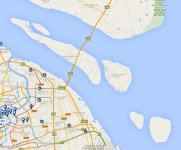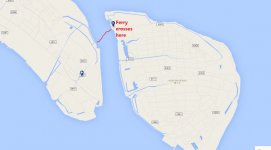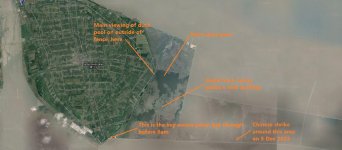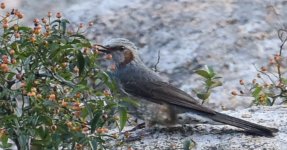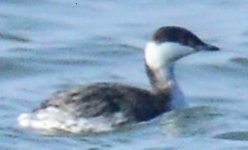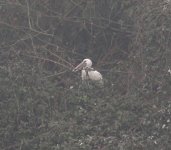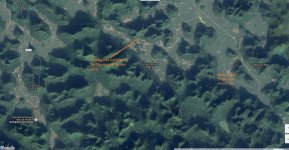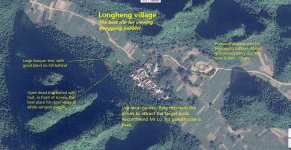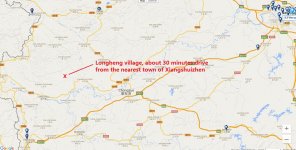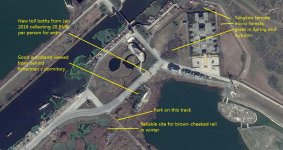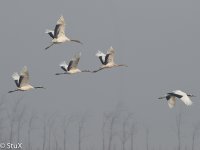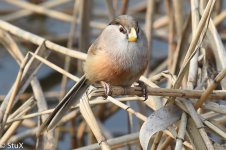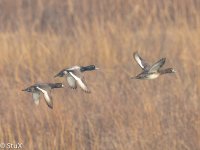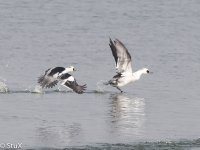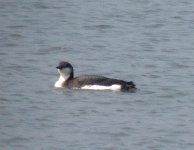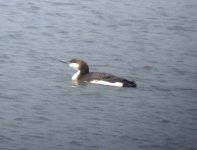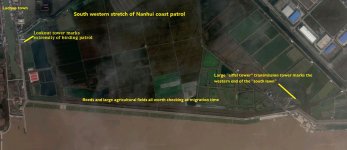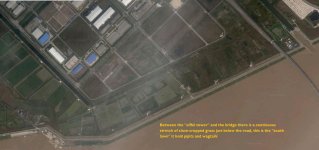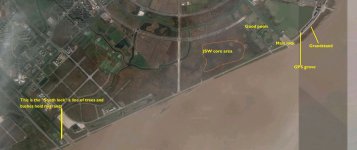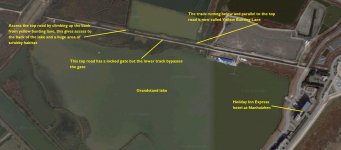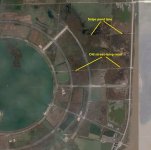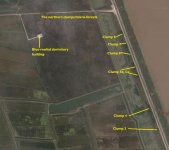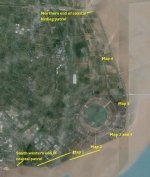Autumn birding, part 1
Long time no write.
A nice trip to Qinghai in late June/early July, see
http://www.shanghaibirding.com/2016/09/02/qinghai-2016-week-1-2/ for nice pictures and a list of birds seen. Qinghai birding can be summed up in one word: thin. Thin air and thin birding. It takes real time and effort to pick up all the species needed. On my trip I saw almost everything I wanted, the biggest misses were Tibetan sandgrouse and Rusty-necklaced partridge. The highlights were Mongolian ground jay, all the snow finch except small, Przevalski’s finch, Tibetan bunting, Tibetan rosefinch, Tibetan babax and Ala Shan redstart.
After a summer in Europe back in Shanghai and out birding every weekend since Aug 20.
My target wader for this Autumn was Asiatic dowitcher. Discovered that on the Nanhui coast they are uncommon in small numbers, usually with black-tailed godwit. I had good views on three successive weekends, a mix of adults and juveniles.
My other tick of the Autumn was Fairy Pitta, see
http://www.shanghaibirding.com/2016/09/04/pitta-nanhui/ for a nice picture.
Over 1-3 October I travelled up to the Rudong coast, spent a whole day on the Dongtai coast (see earlier threads for maps) scored with both Nordmann’s and SBS. On 3 October we found a huge dry high-tide wader roost near Yangkou.
Rather than give a day-by-day breakdown I thought it would be best just to review by species for early/mid Autumn.
I reckon than Autumn migration down the Shanghai coast can be broken into 4 chunks.
1. Late summer. This is from late July to third week of August. This period is the best for waders passing through. Very few passerines
2. Early Autumn. Last week of August to Third week of September. Good numbers of waders but sibe blue robin and Japanese paradise flycatcher dominant passerines of interest.
3. Mid Autumn, from the arrival of the first White’s thrushes around 23 September to the first Pallas’s reed bunting at the end of October. This is the time for thrushes and interesting passerines.
4. Late Autumn, from the end of October to early December, buntings, ducks and thrushes.
Highlight Species list for Autumn 2016 around Shanghai, from 20 August to 3 October 2016
Common pheasant, resident, always seen in small numbers
Chinese bamboo partridge, 1 calling at Yangkou on 3 Oct, I have heard this bird here before, strange occurrence, either a relict population or feral origin.
Ruddy shelduck, one at Nanhui 24 Sep
Very few other ducks except good numbers of garganey early Sep. Many ducks were flying in but too distant on 24 Sep.
BF spoonbill, 35 at Dongtai on 2 Oct
Yellow bittern, few, no Shrenck’s this year yet.
Striated heron, few on the coast mid Sep
Chinese egret, 5 at Dongtai on 2 Oct, a few others around Nanhui. Not common but can be found by scoping through little egrets. Leg colour is variable in Autumn, yellowish black is usual but one had fully greyish green legs, legs noticeably thicker than little. Bill structure diagnostic; slightly taller with a distinctive very slight droop on the distal third.
In flight I can see no difference in structure from little.
No pelicans so far this autumn
Raptors: very poor on this coast, best was a movement of Hobby in late September. Still waiting for a passing grey-faced buzzard.
Japanese sparrowhawk, a few on 1 and 2 Oct
Complete list of waders:
1. Oystercatcher, hundreds of the
osculans race at Dongtai on 2 Oct. This is a potential future split as Korean Oystercatcher.
2. Black winged stilt, usually a small flock to be found at Nanhui
3. Pied Avocet, a few at Nanhui late Sep. Commoner later.
4. Grey-winged lapwing, obvious movement late Sep/early Oct. 50+ seen around Chongming on 1 Oct.
5. Pacific golden plover, an earlier bird, small numbers late August/early Sep
6. Grey plover, big numbers on mudflats at Dongtai 2 Oct
7. Common ringed plover, a single
tundrae at the Pudong sod farms on 3 Sep, a rare bird in China.
8. LRP, a common bird on dry flats
9. Kentish plover, thousands at the roost at Yangkou on 3 Oct
10. Lesser sand plover, thousands at the Yangkou roost on 3 Oct
11. Greater sand plover, a much scarcer bird than lesser, perhaps half a percent are greater.
12. Pintailed snipe, common early September.
13. Swinhoe’s snipe a few late August. IMO
14. Common snipe, arrive mid September, only snipe seen on 2 Oct
15. Asian dowitcher, perhaps 8+ individuals at Nanhui over three weeks
16. Eastern black-tailed godwit, some big flocks of 500+ late August at Nanhui
17. Bar tailed godwit, not common, a few on mudflats.
18. Little curlew, one at Yangkou roost 3 Oct
19. Whimbrel,
variegatus race a strong candidate for splitting as Siberian Whimbrel, commonest mid August
20. Eurasian curlew, hundreds at Dongtai 2 Oct
21. Far-eastern curlew, 30+ at Dongtai on 2 October, I was identifying the bird on their more strident, rasping flight call at Dongtai.
22. Common redshank, not common, a few small flocks on fresh pools at Nanhui.
23. Spotted redshank, by far the commonest wader in the Chinese interior, just a few birds at the coast this Autumn.
24. Marsh sandpiper, commonest in August
25. Common Greenshank, common on the mudflats and pools
26. Nordmann’s greenshank, one hanging around Nanhui through September, 29 counted in front of a quickly-rising tide at Dongtai on 2 October.
27. Green sandpiper, a few on fresh marshes
28. Wood sandpiper, peaks in late August/early Sep
29. Grey-tailed tattler, peak numbers late August, 30+ on a good day.
30. Terek Sandpiper, I counted 155 at roost on a lakeshore at Dongtai on 2 Oct
31. Common sandpiper, always around in small numbers
32. Ruddy turnstone, small numbers at the sod farm 3 Sep a few elsewhere.
33. Great Knot, peak counts of 60+ in late August at Nanhui
34. Red knot, a good year for counts at Nanhui, peak counts of over 100 birds
35. Sanderling, few
36. Red-necked stint, peak in late august, still plenty to see on drier mudflats at Dongtai on 2 Oct
37. Temminck’s stint, 10+ at sod farm 3 Sep, never common.
38. Long-toed stint, peak early September, not really coastal.
39. Sharp-tailed sandpiper, peak counts late August/early September, scarce by October.
40. Curlew sandpiper, peak count of 23 birds on 20 August
41. Dunlin, later to go through and winters on mudflats
42. Spoon-billed sandpiper, I saw two birds on the mud just 80m from the Dongtai seawall road on a falling tide on 2 October, at 3pm I said goodbye with genuine sadness and walked off to find passerines. My companions continued to watch as they came even closer with a peak count of 13 birds including 2 flagged individuals, green left 29 and yellow left 59. Just so sad when you know there is no hope of more than pushing out extinction date by a decade
43. Broad-billed sandpiper, small numbers through Autumn, perhaps more later in season on mudflats.
44. Ruff, I had one in flight early September at Nanhui and just missed another at Nanhui on 25 Sep.
45. Red-necked phalarope, one at Nanhui on 27 Aug
46. Oriental pratincole, 600+ at Pudong sod farms early Sep.
So 46 species of wader so far this autumn, it must be possible get the magic 50 in a season if we get lucky with say Pec sand, white-rumped sand, buff-breast, long-billed dowitcher and a rare plover?
Gulls, never seen Saunders’s at Nanhui but counted 430 at the Yangkou roost on 3 Oct.
Black-headed gull, start to move through late September, plenty at Dongtai and Yangkou early October.
Vega gull, the common large gull, now includes Mongolian
Black-tailed gull, looks a proper big gull in flight but when roosting just a bit bigger than black-headed, common gull sized. Peak counts around 20.
Heuglins, a nice adult at Dongtai on 2 October.
The Nanhui coast is very poor for gulls, still looking for Relict and slaty-backed as well as any white-winged gull in winter. Common gull is a major bogey on my China list.
Sea Terns. Caspian and gull-billed regular at the coast. Common tern in very small numbers a few little terns. No other sea terns yet seen.
Marsh terns, white-winged tern peaked at 3000 on 17 Sep at Nanhui, whiskered tends to become commoner later.
Red turtle dove, 10+ around the southern patrol at Nanhui through early September
Cuckoo’s: Very hard work in Autumn, presumed mostly common in late Aug and through September, 3 Lesser cuckoo seen well at Yangkou 3 Oct
Lesser coucal, presumed an elusive breeder at Nanhui, a few seen.
Himalayan swiftlet, not a vagrant to the coast but and uncommon early autumn migrant seen most weeks in late August/early Sep
Fairy Pitta. The stand-out bird of the Autumn. We refound a bird in microforest 2 on 3 Sep, this bird hung around until the next weekend attracting a huge crowd of photographers. We found another on 10 Sep at MF 4. It is clear that Fairy Pitta is a regular migrant on the Nanhui coast. By far the best bird I have seen this year.
Part two to follow…




